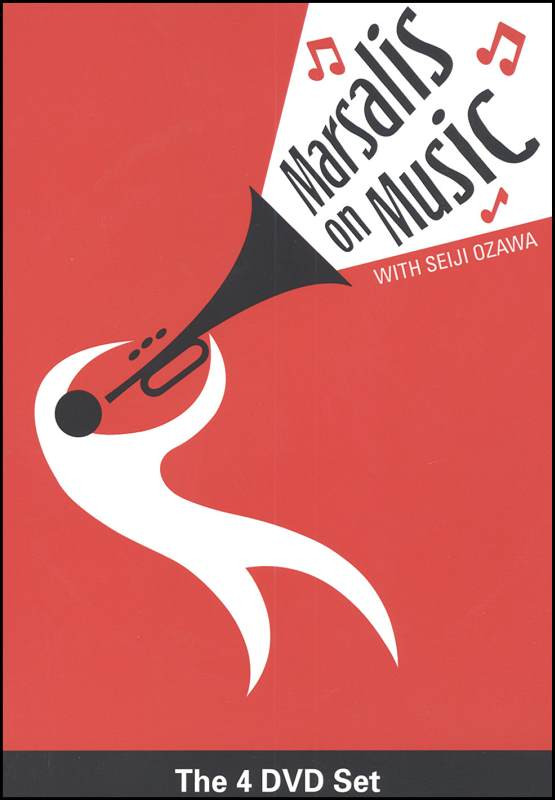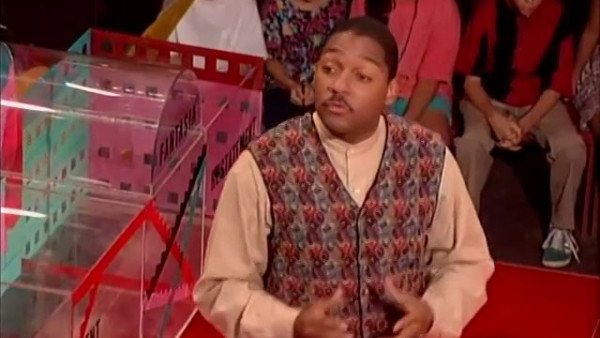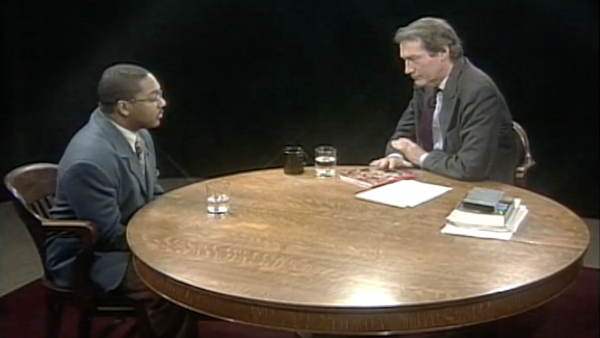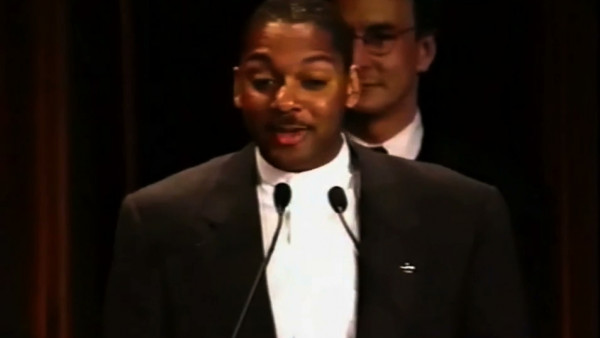Marsalis on Music
This Peabody Award winning PBS program, Marsalis on Music, is available as a 4 DVD box set. This series is hosted by world famous jazz musician and distinguished classical performer, Wynton Marsalis. With the help of his Multiple Ensembles and Tanglewood students led by Seiji Ozawa, Wynton puts a fresh spin on music and music appreciation. His playful and inspired instruction, reinforced by superb performances and exciting graphics, not only teaches the fundamentals of music, but also makes learning fun.
A companion book to this outstanding PBS series is also available for purchase separately: Marsalis On Music Companion Book

Album Info
| Ensemble | Multiple Ensembles |
|---|---|
| Release Date | August 19th, 1995 |
| Record Label | Devine Enterteinment Corporation |
| Catalogue Number | DNM 95001 |
| Formats | DVD, VHS |
| Genre | Jazz Recordings |
Track Listing
| Track | Length | Preview |
|---|---|---|
| DISC 1: Why Toes Tap: Marsalis on Rhythm | ||
| Opening credits and theme | ||
| Wynton introduces the concepts of melody, rhythm and meter. | ||
| Wynton introduces the organizing concepts in music; bars, rests and measures. | ||
| Wynton introduces tempo and its importance in imparting energy and feeling to music. | ||
| Wynton talks about the great importance ground rhythms have in influencing how we hear a piece of music. | ||
| Wynton talks about the contrasting use of drums and percussion in the orchestra and the jazz band. | ||
| Wynton emphasizes the importance of playing with intensity and exuberance no matter whatthe tempo of the piece. | ||
| Wynton touches for the first time on the importance of syncopation (he will re-address and expand on this in Sousa to Satchmo). | ||
| Wynton summarizes the principles learned in the show | ||
| Final Credits | ||
| DISC 2: Listening for Clues: Marsalis on Form | ||
| Opening titles, credits and theme | ||
| Wynton provides an overview to the concepts of form and repetition | ||
| Wynton introduces the 3 part Sonata form - Statement, Fantasia and Re-Statement - and concentrates particularly on the first part the Statement. | ||
| Wynton expands upon the Fantasia part of the 3 part Sonata form. | ||
| Wynton expands on the concept of key and explains how the first and second themes return to the same key in the Re-statement section of the Sonata form. | ||
| Wynton and his Jazz Orchestra perform George Gershwin’s “I Got Rhythm”, which he uses to introduce popular music’s 32 bar song form. | ||
| Wynton illustrates AABA song structure featuring multiple choruses as thq orchestra performs Duke Ellington’s “Cottontail”. | ||
| Wynton introduces the concept of variations on a theme and how these variations can be affected by changing key, rhythm and slightly altering structure. | ||
| Wynton teaches the blues form, using a generic 12 bar chorus to illustrate the 1111–4411–5411 chord structure. | ||
| Prior to performing Duke Ellington’s “Happy Go Lucky Local” Wynton summarizes all of the various musical clues that have been touched upon in the show. | ||
| Final Credits. | ||
| DISC 3: Sousa to Satchmo: Marsalis on the Jazz Band | ||
| Opening Theme and credits. | ||
| Sousa’s “Stars and Stripes Forever” is performed by The Tanglewood Music Center Wind Band. | ||
| Wynton introduces the wind band and the March form. He also introduces the Composer/Bandleader John Philip Sousa. | ||
| Wynton introduces ragtime and expands on how it bridged the music of the Midwest with the music of the South. | ||
| In this chapter, Wynton introduces the roots of New Orleans Jazz. | ||
| In this chapter, Wynton introduces the notion of Jazz as collective improvisation. | ||
| Here, Wynton expands on call & response. | ||
| Wynton talks about the cornet and also touches upon the notion of expert techniques and variations on a single theme. | ||
| Wynton talks about the great pioneers of Jazz, in particular Buddy Bolden and Louis Armstrong. | ||
| Wynton summarizes all of the main themes of the episode. | ||
| Final Credits. | ||
| DISC 4: Tackling the Monster: Marsalis on Practice | ||
| Yo-Yo Ma performs Shostakovich’s “Cadenza” from Cello Concerto No. 1 in E-Flat Major, 0p. 107. | ||
| Wynton and Yo-Yo discuss practicing and their own thoughts about it. Wynton introduces Ellington’s “Mood lndigo” as his favorite piece of music. | ||
| Wynton performs “Mood lndigo” with The Wynton Marsalis Jazz Trio (piano, bass, drums). | ||
| Wynton introduces his 12 Rules For Successful Practice regimen and talks about the first 4 | ||
| Student virtuoso trumpeter Mark lnouye performs Hummell’s “Rondo, Allegro Molto” (from Trumpet Concerto in B Flat Major), accompanied by Yo-Yo and student pianist Melvin Chen. | ||
| Wynton introduces the next 4 rules for successful practice | ||
| Wynton talks about the importance of group practice. Yo-Yo and a trio of Tanglewood cello students perform J.S. Bach’s “O Sacred Head Now Wounded” (from The Christmas Oratorio). | ||
| Wynton talks about rehearsal and group practice. Yo-Yo and his Tanglewood cello trio rehearse and perform Prokofiev’s “March” (from Love for Three 0ranges). | ||
| Wynton discusses sound and why every musician should try to establish their own sound. | ||
| Wynton and Yo-Yo play around with “Mood lndigo” in a call and response format. | ||
| Randall Haywood performs Charlie Parker’s “Cool Blues” accompanied by The Wynton Marsalis Jazz Trio | ||
| Wynton concludes his 12 part practice regimen with his final 4 thoughts on practice | ||
| Using what they have learned earlier, Wynton and Yo-Yo perform “Mood Indigo” accompanied by the Wynton Marsalis Jazz Trio. | ||
| Closing Credits. | ||
Liner Notes
Why Toes Tap: Marsalis on Rhythm
CHAPTER DESCRIPTIONS
1) Opening credits and theme
2) Wynton introduces the concepts of melody, rhythm and meter. He establishes the fact that without rhythm, there can be no music.
He contrasts the odd meter feel of Tschaikovsky’s “Waltz of the Flowers” to the even meter feel of the Duke Ellington/Billy Strayhorn arrangement of the same piece.
Throughout the DVD, pieces from Tschaikovsky’s “Nutcracker Suite” and the Ellington/Strayhorn’s modern jazz arrangement of “The Nutcracker” are used illustratively.
3) Wynton introduces the organizing concepts in music; bars, rests and measures. He also establishes that there can be a range of motions in music and has the viewer visualize the motion of the notes on the page of a score. The Classical and Jazz versions of “The Nutcracker March” are performed to illustrate motion.
4) Wynton introduces tempo and its importance in imparting energy and feeling to music.
The “Russian Dance” is performed at proper tempo and at a slower speed to illustrate this principle.
5) Wynton talks about the great importance ground rhythms have in influencing how we hear a piece of music. He also touches on the importance of beat and pulse – the 1, 3 classical pulse as opposed to the jazz backbeat of 2, 4.
“Sugar Plum Dance” is performed to illustrate how the changing ground rhythm affects how we hear the music.
6) Wynton talks about the contrasting use of drums and percussion in the orchestra and the jazz band. He develops the concept of the rhythm section in the jazz band being the motor of the band. Drums, bass and piano are the swinging foundation that the jazz band works on top of.
7) Wynton emphasizes the importance of playing with intensity and exuberance no matter what the tempo of the piece. To illustrate this, they perform both the classical and jazz versions of “Dance of Reeds”.
8) Wynton touches for the first time on the importance of syncopation (he will re-address and expand on this in Sousa to Satchmo). He emphasizes the need in music to purposely go against the meter, to do something unexpected from time to time to keep the listener’s ear and make the music interesting.
9) Wynton summarizes the principles learned in the show:
I) If there’s no rhythm, there’s no melody and no music.
II) There can be odd and even feel meters.
III) The meter is defined in measures.
IV) Tempos can be fast, slow or anything in between.
V) Varying accents and rhythms enhance music.
VI) The ground rhythm establishes the music’s vitality.
VII) In jazz, the rhythm section swings.
VII) You have to always play with intensity and soul.
IX) Syncopation keeps music interesting by doing the unexpected.
To wrap up, “The Nutcracker Overture” is performed in both the classical and jazz versions.
10) Final Credits.
––––––––––––––––––––––––––––––––
Listening for Clues: Marsalis on Form
CHAPTER DESCRIPTIONS
1) Opening titles, credits and theme.
2) Wynton provides an overview to the concepts of form and repetition.
3) Wynton introduces the 3 part Sonata form – Statement, Fantasia and Re-Statement – and concentrates particularly on the first part the Statement. The Tanglewood Center Orchestra performs excerpts from Prokofiev’s “ClassicaI Symphony” throughout the exploration of the Sonata form. The audience listens for the first and second themes. Wynton also comments on transitions, introductions and endings.
4) Wynton expands upon the Fantasia part of the 3 part Sonata form. He details how the Statement themes are explored by moving from section to section and from key to key, He also contrasts major and minor keys.
5) Wynton expands on the concept of key and explains how the first and second themes return to the same key in the Re-statement section of the Sonata form. The audience listens for all of the clues as the Orchestra performs the l st Movement of Prokofiev’s “Classical Symphony”.
6) Wynton and his Jazz Orchestra perform George Gershwin’s “I Got Rhythm”, which he uses to introduce popular music’s 32 bar song form. He expands upon this to include the AABA song structure, the bridge and the chorus. He also relates this modern structure back to the 3 Part Sonata Form.
7) Wynton illustrates AABA song structure featuring multiple choruses as the orchestra performs Duke Ellington’s “Cottontail”. Students listen for the AABA structure and note the various types of choruses; solo, section and full band.
8) Wynton introduces the concept of variations on a theme and how these variations can be affected by changing key, rhythm and slightly altering structure. To illustrate further, the Orchestra performs Ives’ “Variations On America”.
9) Wynton teaches the blues form, using a generic 12 bar chorus to illustrate the 1111–4411–5411 chord structure. He also has the students sing the steps between the chords. As well, the riff chorus and call and response chorus are illustrated within the blues form.
10) Prior to performing Duke Ellington’s “Happy Go Lucky Local” Wynton summarizes all of the various musical clues that have been touched upon in the show. The Jazz Orchestra then performs “Happy Go Lucky Local”, a jazz standard.
11) Final Credits.
–––––––––––––––––––––––––––––––
Sousa to Satchmo: Marsalis on the Jazz Band
CHAPTER DESCRIPTIONS
1) Opening Theme and credits.
2) Sousa’s “Stars and Stripes Forever” is performed by The Tanglewood Music Center Wind Band.
3) Wynton introduces the wind band and the March form. He also introduces the Composer/Bandleader John Philip Sousa.
4) Wynton introduces ragtime and expands on how it bridged the music of the Midwest with the music of the South.
The chapter includes performances of Scott Joplin’s “Maple Leaf Rag” on piano and also byThe Tanglewood Music Center Orchestra. As well, a ragtime piano roll is featured on a player piano.
Wynton discusses how marches and ragtime are interrelated and led to the advent of New Orleans Jazz.
Musical concepts introduced include ragging, syncopation, the two beat feel, sixteen bar strains and the trio section of the composition.
5) In this chapter, Wynton introduces the roots of New Orleans Jazz.
Concepts include improvisation, cadence, and musical communication.
With the Liberty Brass Band, Wynton compares the treatment of “High Society March” as performed in the classic style by the Tanglewood Wind Band with the same piece performed in the New Orleans Jazz style.
6) In this chapter, Wynton introduces the notion of Jazz as collective improvisation.
Both The Tanglewood Orchestra and the Liberty Brass Band perform “The Stars and Stripes”, one in the classic manner, the other as a Jazz arrangement.
Concepts introduced include: beat vs. groove, polyphony, register, trombone tailgating and call & response.
7) Here, Wynton expands on call & response.
He and the Liberty Brass Band perform “The Whoopin’ Blues”.
Concepts introduced include the riff and the solo break.
8) Wynton talks about the cornet and also touches upon the notion of expert techniques and variations on a single theme. Mark Inouye, a virtuoso student at Tanglewood, performs the cornet showpiece “Variations on the Carnival Of Venice”.
9) Wynton talks about the great pioneers of Jazz, in particular Buddy Bolden and Louis Armstrong.
He and the Liberty Brass Band perform Armstrong’s “Cornet Chop Suey”.
10) Wynton summarizes all of the main themes of the episode.
Both the Tanglewood Orchestra and The Liberty Brass Band perform J.P. Sousa’s “Manhattan Beach March”.
11) Final Credits.
–––––––––––––––––––––––––––––––––––
Tackling the Monster: Marsalis on Practice
CHAPTER DESCRIPTIONS
1) Yo-Yo Ma performs Shostakovitch’s “Cadenza” from Cello Concerto No. 1 in E-Flat Major, Op. 107.
2) Wynton and Yo-Yo discuss practicing and their own thoughts about it. Wynton introduces Ellington’s “Mood Indigo” as his favorite piece of music.
3) Wynton performs “Mood Indigo” with The Wynton Marsalis Jazz Trio (piano, bass, drums).
4) Wynton introduces his 12 Rules For Successful Practice regimen and talks about the first 4:
I) Seek Help. Get a teacher.
II) Make a schedule. Organize yourself.
II) Set Goals to chart your development.
IV) Concentrate when you practice.
Wynton and Yo-Yo practice “Mood lndigo”.
5) Student virtuoso trumpeter Mark Inouye performs Hummell’s “Rondo, Allegro Molto” (from Trumpet Concerto in B Flat Major), accompanied by Yo-Yo and student pianist Melvin Chen.
6) Wynton introduces the next 4 rules for successful practice:
V) Relax, practice slowly. Tempo and speed will come.
VI) Practice longer on things that you can’t play.
VII) Play everything with the maximum expression.
VIII) Don’t be too hard on yourself.
7) Wynton talks about the importance of group practice. Yo-Yo and a trio of Tanglewood cello students perform J.S. Bach’s “O Sacred Head Now Wounded” (from The Christmas Oratorio).
8) Wynton talks about rehearsal and group practice. Yo-Yo and his Tanglewood cello trio rehearse and perform Prokofiev’s “March” (from Love for Three 0ranges).
9) Wynton discusses sound and why every musician should try to establish their own sound. Young trumpet player Randall Haywood and Wynton work on establishing Randall’s sound and Wynton shows him a few tricks.
10) Wynton and Yo-Yo play around with “Mood Indigo” in a call and response format.
11) Randall Haywood performs Charlie Parker’s “Cool Blues” accompanied byThe Wynton Marsalis Jazz Trio.
12) Wynton concludes his 12 part practice regimen with his final 4 thoughts on practice:
IX) Don’t show off.
X) Think for yourself – find your own way.
XI) Be optimistic.
XII) Always look for connections to other things.
13) Using what they have learned earlier, Wynton and Yo-Yo perform “Mood Indigo” accompanied by the Wynton Marsalis Jazz Trio.
14) Closing Credits.
Credits
Marsalis on Music is the young people’s music series of our time.
The series is hosted by Wynton Marsalis, the most popular and acclaimed jazz musician of his generation, as well as a distinguished classical performer. Helped by his jazz band and students from Tanglewood, led by Seiji Ozawa, Wynton puts a fresh spin on music and music appreciation. His inspired instruction, reinforced by superb performances and exciting graphics, not only teaches the fundamentals of music, but also makes learning fun.
This 4 DVD set contains the following series episodes:
- WHY TOES TAP – Marsalis on Rhythm
- SOUSA TO SATCHMO – Marsalis on The Jazz Band
- LISTENING FOR CLUES – Marsalis on Form
- TACKLING THE MONSTER – Marsalis on Practice – With special guest Yo-Yo Ma
Credits
A Peter Gelb/PatJaffe Production
All Episodes written by Wynton Marsalis
Wynton Marsalis is represented by Edward Arrendell of The Management Ark, Inc.
Performers:
Why Toes Tap: Wynton Marsalis, The Wynton Marsalis Jazz Orchestra, Seiji Ozawa, The Tanglewood Music Center Orchestra
Listening For Clues: Wynton Marsalis, The Wynton Marsalis Jazz Orchestra, Seiji Ozawa, The Tanglewood Music Center Orchestra
Sousa to Satchmo: Wynton Marsalis, Seiji Ozawa, The Liberty Brass Band, The Tanglewood Music Center Wind Band, Mark Inouye (trumpet), Eric Reed (piano). The Tanglewood Music Center Orchestra
Tackling The Monster: Wynton Marsalis, Yo-Yo Ma (cello), The Wynton Marsalis Jazz Trio, Randall Haywood (trumpet), Mark Inouye (trumpet), Kari Docter, Julian Hersh, Jennifer Porsches (all cello), Melvin Chen (piano)
Product Details
- Format: NTSC
- Language: English
- Region: Region 1
- Number of discs: 4
- Studio: Devine Ent. Corp.
- Run Time: 208 minutes
Personnel
- Seiji Ozawa – conductor
- Yo-Yo Ma – cello
- Dan Miller – trumpet
- Kenny Rampton – trumpet
- Peven Everett – trumpet
- Randall Haywood – trumpet
- Stan Wilkerson – trombone
- Andre Atkins – trombone
- Wycliffe Gordon – trombone
- Wess “Warmdaddy” Anderson – alto sax, sopranino sax
- Andy Farber – tenor sax, clarinet
- Victor Goines – tenor sax, soprano sax, clarinet, bass clarinet
- Gideon Feldstein – baritone sax, bass clarinet
- Eric Reed – piano
- Ben Wolfe – bass
- Herlin Riley – drums, tambourine
Also of Interest
-
 Videos
Videos
Marsalis on Music - DVD trailer
-
 Videos
Videos
Wynton discusses his show on PBS, “Marsalis on Music.” - Charlie Rose Show
-
 Videos
Videos
A Peabody to Wynton Marsalis: Making the Music and Marsalis on Music (1995)
-
 News
News
Wynton Marsalis’ 12 Tips on How to Practice: For Musicians, Athletes, or Anyone Who Wants to Learn
-
 News
News
Marsalis on Music DVD trailer available
-
 News
News
Marsalis on Music available on DVD
-
 News
News
“Marsalis on Music” reviewed on All About Jazz
-
 News
News
Wynton Marsalis, Top Tutor
